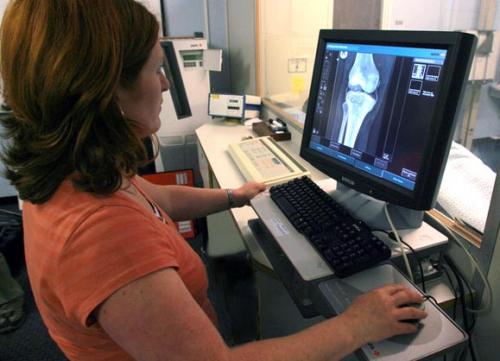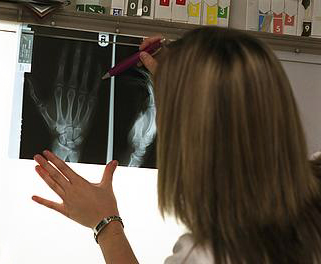Thank you for visiting the Amarillo College Radiography program website and for your interest in a Radiography career.
The content presented in the different sections of this website is designed to provide you with the information and forms you will need to make application to the program and to learn more about the radiography profession. Please read through all pages very carefully and complete all forms in accordance with the instructions given. Failure to follow instructions could VOID your application.
The AC radiography program was started in 1968 and currently graduates approximately twenty-five students each year. The program is fully accredited by the Committee on Allied Health Education Accreditation (CAHEA) in cooperation with the Joint Review Committee on Education in Radiologic Technology* (JRCERT). In addition, all program courses are approved through the Texas Higher Education Coordinating Board (THECB). Since 1895, when Wilhelm C. Roentgen discovered x-rays, radiology science has advanced to include some of the most sophisticated technological equipment found in any medical-related profession. Advances in technology along with the expansion of radiology departments throughout the country continue to create a strong demand for professionals educated in radiography. Radiographers combine the high technology of diagnostic medical imaging with their patient care skills to create x-ray images called radiographs. These radiographs are then used by radiologists and other physicians in the detection, diagnosis and treatment of disease and injury.
Radiography (also known as Radiologic Technology) is a profession that requires a dependable personality with a mature and caring nature. In addition, the radiographer’s role on the health care team demands the ability to make timely decisions on a daily basis and accept responsibility for those decisions. Most people enter the profession because they are motivated to help others who are ill or injured, while others may envision a degree in Radiography as a "stepping stone" to further education within the medical professions.
Education programs for radiographers are conducted in cooperation with radiology departments in and around the city where the program is located. The Amarillo College program is directly affiliated with acute-care hospitals in Amarillo, Borger, Dumas, Hereford, and Pampa. Radiography students also rotate through free-standing imaging clinics and private physician offices during their time at AC. The curriculum requires traditional on-campus coursework and six semesters (two years) of off-campus clinical experience called "Practicums." During these six practicum courses, students will accumulate about 1,700 clock hours of "live" practical experience in multiple radiology departments before graduation day arrives.
Radiographers are primarily employed in hospitals, but many work in out-patient clinics and physician offices. Demand for radiographers continues to remain strong, and the profession offers a high degree of job security. Salaries for radiographers are competetive with other health-care professions requiring a similar education. And, most radiographers enjoy the generous benefit packages associated with employment in an health profession.
Applications for the AC Radiography Program are accepted from September 1 through the last workday of May of each academic year with a new group beginning each Fall Semester. Enrollment in the program is limited in accordance with JRCERT* accreditation standards. At present, there are tweny five positions available per class. Students are accepted into the program in strict accordance with very specific admission criteria that is described in other parts of this website.
EQUAL EMPLOYMENT POLICY:
Amarillo College is an equal opportunity college. It is the policy of Amarillo College not to discriminate on the basis of sex, disability, race, color, age, religion, or national origin in its radiography program, related activities, or employment as required by Title IX, Section 504, Title VI, and Age Discrimination Act of 1978. Amarillo College will take steps to assure that lack of English language skills will not be a barrier to admission and participation in the radiography program.
* Joint Review Committee on Education in Radiologic Technology (JRCERT)
20 N Wacker Drive, Suite 2850
Chicago, IL 60606-3182
312-704-5300
E-mail: mail@jrcert.org

Radiographers (also called radiologic technologists) are health professionals who use their expertise and skills in performing medical imaging procedures using x-radiation to produce images called radiographs. The radiographs are then used to assist physicians in diagnosing disease and trauma.
In order to produce quality radiographs, radiographers must be able to effectively maneuver and accurately control some of the most high-tech and expensive medical equipment found anywhere in the hospital. And, while using the equipment, the radiographer must always closely observe appropriate radiation protection practices to ensure a radiation safe environment for the patients and personnel.
Additional information concerning a career in Radiography can be seen at the American Society of Radiologic Technologists web site.
During each imaging procedure, the radiographer is responsible for the patient's physical comfort and safety and must be able to recognize and respond to any medical emergency that may occur while the patient in his or her care.
Finally, the radiographer must be able to analyze each finished radiograph for quality and acceptability, and quickly demonstrate effective problem-solving techniques in correcting any images that are less than optimal.
Advanced technical knowledge and human compassion are the two most important characteristics of the radiographer. Other very important characteristics are these:
- Likes people
- Is friendly
- Has good moral character
- Welcomes responsibility
- Is dependable
- Is organized
- Can make quick and responsible decisions
- Has critical thinking (problem solving) skills
- Pays attention to detail (remains focused)
- Demonstrates initiative
- Works hard
- Finishes what is started
- Can readily adapt to change
- Likes to be challenged
- Works well under stress
- Is a "team-player"
- Is "easy-going"
- Can accept and use constructive criticism
- Demonstrates a general concern for health by living healthy
If you can identify with these characteristics and if you would like a rewarding career in a growing profession with exciting new technology and job opportunities around the world, radiography may be the health profession for you.

